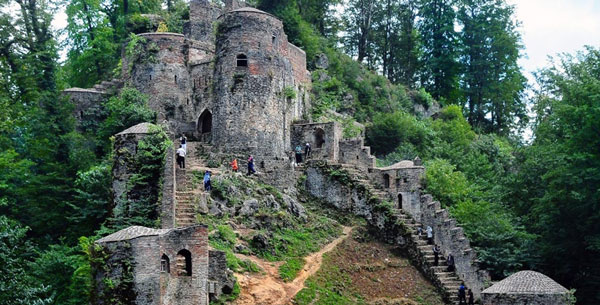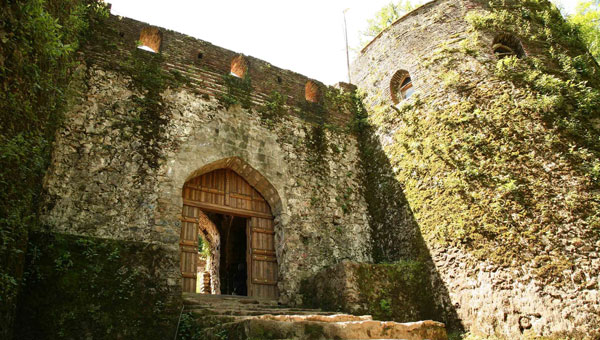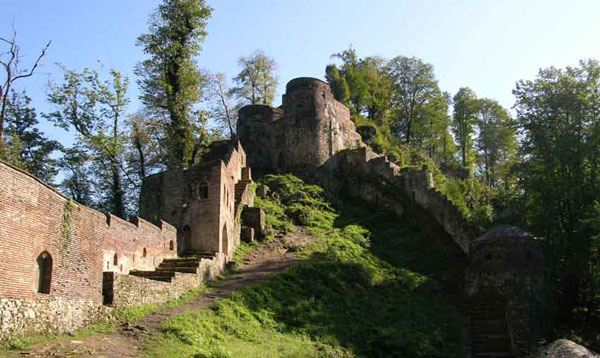History of the Rudkhan fortress, the strongest fortress in Gilan
Natural phenomena and historical sites are two major categories of tourism destinations throughout the world, each of them have their own fan and lover. Some tourism spend their leisure time in nature, and others prefer to spend their time visiting historical and ancient sites and getting information about them. Sometimes, nature blends in with history and fascinates both and make enchant tourism.
Iran for it’s special location has four season climate and all sites of it attracts every seeker. in another side Iran has a long and ancient civilization and historical background dating back several thousands of years, and the effects of this ancient civilization can be seen everywhere on the border. At some corners in this area, nature and history have come together to create an extraordinary effect. One of these points is the “Castle of Roodkhan” in Gilan province in northern Iran, which always attracts many tourists, naturalists and historians.
“Rudkhan Fortress” or “Hesami Castle” or “Castle of Rudkhan” are all three castle names that are located on the forested heights of Fouman city in Roudkhan village in Gilan province which belongs to the Seljuk era. The fortress is about 30 km from Fouman, about 25 km from Makwan, about 45 km from Masoule and about 20 km from Shaft.
this castle is considered as the largest brick castle in Iran. it has an area of 2.6 hectares, with two towers and a barrow. The wall of the castle is 1500 meters long. Rudkhan Castle is located at an altitude of 665 to 715 meters above sea level and on the right is a river with the same name.

Some experts believe that the fortress was built during the Sassanid era and coincided with the Arab invasion to Iran. Due to its strategic and defensive position during the Seljuq era, the fort was rebuilt and used as one of the Ismaili Alamut fighting bases.
The inscription on the entrance hall of the castle, which is now kept in the Rasht Treasury Museum, states that the castle was rebuilt for Sultan Hessam al-Din in the 5th and 7th centuries. Amir Hessam al-Din Debaj Foumani (Muzaffar al-Sultan), the ruler of Beihpas, was the first regional power to disobey the Safavids, rebuilding the Khan River fort to resist it. But it didn’t succeed and finally he escaped to the Darband and excuted in the Tabriz. (N Azimi ,Entrance of TerribleAzimi), (T, Safavi, unaware prepetrators of Gilan history)
For the first time in 1830, a Polish scholar named Alexander Czdecko Khcheko, while conducting research in Gilan, first saw the fortress of the river and recorded its location in his notes. He wrote about the Rudkhanfortress: “A fortress is on top of a mountain on the upper river by the same name, its roof is stone and the sides of the entrance have two strong defensive towers, and the inscription on the entrance is engraved for the first time. It has been renewed for the reign of Sultan Hussam al-Din Amir al-Din al-Ishaq in the 918 to921 AH.

this fortress becouse of it’s historical worth , rebuilt base on the strategic and martial features, architecture structure in the August of the 1974 and listed in the historical and natinal monuments list in Iran(S, Lotfinia, Tourism- unrechable beauty, Amrdad Weekly, Sunday, December 24, Year 13, Issue 289, p 8).
During archaeological excavations in the area, many historical objects have been discovered that belong to the Safavid era, including glazed and glazed hand-made pottery and glazed triangular tiles with burnt brown glaze, hexagonal tiles. Large pointed to turquoise, blue-glazed tiles, and King Abbasi’s white flowers( it is a name for the kind of traditional panting in Iran)
In the Talish language, the fortress’s native name is “Peak of Rokvon” and the name “Castle of the Rudkhan”, the official name of the place, is the Persian synonym for its native name. The reason for naming this fort, the name of the river Rudkhan, or the peak of Rokvon, is because it was built by the river Rokvon, and the river Rudkhan means the castle by the river. This castle has various names in different periods of history, including the fortress of Hazar-e Pale, Hesami, Seksar, Segsar and Segal. Hesami was named after the fort because it was renovated by Hesamuddin Debaj Ishaqi. The title of the thousand stairs is also obvious, given the number of stairs reaching the castle. The name of the Sagsal is also referred to it as the fortress because it was made in the year of the dog (SAg in persian)

The importance of Rudkhan castle architecture in choosing the right place for the structure is the use of durable materials and the use of various methods in its architecture.Like many other castles, the castle is built at high altitudes and has a steep slope to make it difficult for the enemy to forest alonge the mass forest and roaring river In the fort, the walls vary in height from 3 to 10 meters, and in the more sensitive areas of the castle, the walls and towers are constructed with greater diameter and height.The materials used in the construction of the castle are mainly stone fragments that have been cut in different dimensions from the rocks around the castle and used in most of its construction. The upper floors of the towers and barracks, as well as the covering of the ceilings and floors have been used with bricks.Wood, plaster mortar, mortar, lime and ash are other materials used in the construction of the river fortress.
In the introduction of different parts of the Rudkhan castle, can be said that the entrance to the castle is through the main gate located in the northern part of the fort and because of its steep incline and two large towers on either side, it has become less accessible to enemies. on either side of the entrance gate, there are two platforms which is made by rock carcass and 5.1 meter high And were used as a place for guards and protectors. Entrance door is made of twig arch (curved apex) 6.2 m wide and 5.3 m high and directs people to a hallway.There are platforms on either side of the corridor, so they can be said to have a dock. Passing through this corridor, the castle’s courtyard appears, and from there you can climb a few stairs to the roof top of the gate. The narrowest part of the castle and the confluence of the towers and the northern and southern barrows are about 2 meters from the main gate and the eastern gate is also located. On either side of the gate, the towers are filled at the bottom, hollow at the top, and look cylindrical on the outside, with octagonal chambers inside. The towers were a place to protect the guards from the wind, storm and winter cold. To the south of the castle is a mountain river that has a cave in its heart. Indigenous people in the area believe that the cave was used as a place to guard troops in the past. And the troops would alert the inhabitants of the castle if there were any signs of attack.
In the middle of the castle and in the deepest part of the castle there is a water supply which in ancient times the water needed for the castle was guided by tombs (yellow pipes) from the village of Zardkhoni in the western highlands to the middle basin. This water storage is located in the western part, at a height of 687meters above sea level and its approximate area is 130 square meters. Due to the importance of water supply (Abanbar) conservation and its vital role in providing water to the castle, two rows of watchtowers were erected on the roof and on two floors so that guards could control it. After the earthquake in Gilan (1990), no more water came into the water reservoir; but in the folowing years, the Guilan Cultural Heritage and Tourism Organization attempted to revive it. Nowadays, the water needed to transport the castle and visitors to the castle from the same place and path with plastic pipes is stored in a new storage water supply.
In general, it can be said that the fort consisted of two parts, the Citadel, which was the residence of the ruler and his close family (harem), as well as the part of the Ghoorkhaneh, which was the site of military activities and the lives of soldiers. The citadel is located in the western part of the fort, on two floors, and is made of brick. The home guird are dominated in the east by two floors with numerous windows and aperture.The eastern part of the castle consists of twelve entrances, a prison, an emergency door, a bathroom and a drainage. The western part has twelve entrances. Other western buildings include a fountain, a pond, a water reservoir, a refrigerator, a bathroom, a king-size enclosure, and several residential units surrounded by towers and barracks. It also encompasses forthy watchtowers around the castle, with octagonal rooms covered with dome arches. Around the walls and towers there are sloping holes built into the molten material for shooting and shooting.
one of the interesting and fascinating facts about the history of the Rudkhan castle is that, the enemy has never peretrated it and no enemy has been able to conquer it. To reach this historic fortress that is nestled in the lush nature of Gilan province, you must cross a forest road and continue down the forest. It is difficult to reach the castle where you have to climb a thousand steps to visit it. It should be noted, that the route to the fort beside the roaring river provides such a space that you will be repeatedly stumbling along the path to watch this volume of beauty and the tiredness of the road ahead will reduce. Sightseeing and photography in the fortress of the river is one of the many fun adventures. There are also local restaurants before you take the stairs, giving you the opportunity to experience local cuisine. Next to these restaurants are ateliers where you can take a snapshot with native clothes. Here you can also buy local handicrafts and local products.
If your next trip is to the Rudkhan Fortress and you are planning about staying overnight, you can use hotels or guesthouses in the surrounding towns or select local houses and villas for your nightlife.If you are familiar with the basics of camping you can also camp in the beautiful nature of this area.
The best season to visit the river and see the natural and historical beauty of spring and summer. In the fall and winter, access to the castle will be slippery and dangerous due to the rain and snow. Choose the right shoe to visit the Rudkhan Fortress, as you will have about two hours of hiking.
To get to the Rudkhan castle you first have to go to Gilan province and Fouman city. After crossing the villages of Gasht, Kord Mahale,Rudkhan Gasht , Siahkesh, Goorab Pas, Malaskam, Saeedabad (Sayedabad) you will reach the village of Qaleh Rudkhan ( Rudkhan castle). In this area, you must continue on your way to the car park after crossing the Hyderabad. At this place, get off the car and after crossing numerous shops on the sandy path you will reach the foot of the mountain. From here, you will see the entrance to the fortress of Rudkhan in front of you, following the 5.1 km route and walking about 1000 steps. Visiting the castle is daily from 7.00 am to 5:00 pm.





